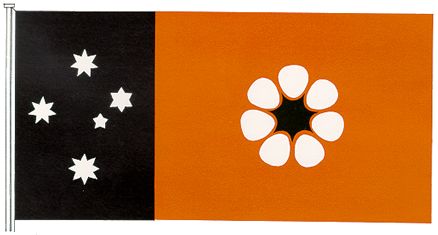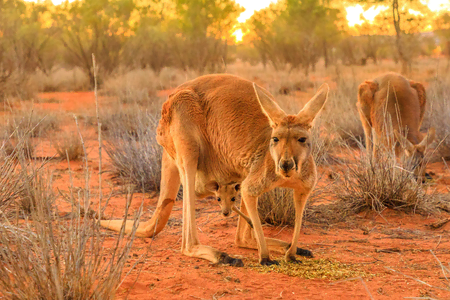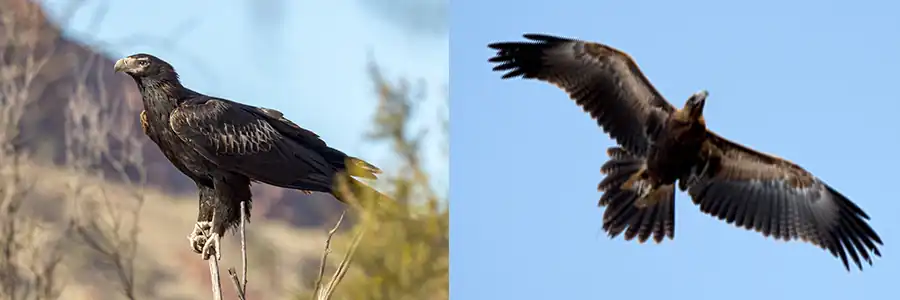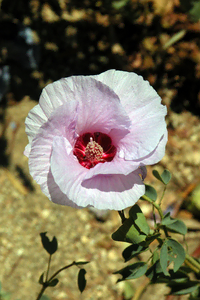Official symbols and emblems
This page has information on the Northern Territory (NT) flag, Coat of Arms and other official emblems.
Official emblems of the Territory are protected under the Flag and Emblem Act 1985 (the Act).
Northern Territory flag

The NT flag was flown for the first time at a ceremony in Darwin on 1 July 1978 marking the grant of self-government.
The flag design incorporates the 3 Territory colours: black, white and red ochre. It features a stylised depiction of the Sturt’s desert rose, the Territory’s floral emblem, on the red ochre panel.
The desert rose has 7 petals, with a 7 pointed star at its centre, representing the 6 Australian states and the NT.
On the black panel to the left, 5 white stars form the Southern Cross, a prominent symbol in Australian iconography.
The flag was designed by Australian artist Robert Ingpen AM, whose work is well known throughout Australia. To find out more go to the Robert Ingpen website.
There are long-standing traditions and rules of how a flag should be displayed.
The image of the NT flag is protected under the Act.
If you want to use an image of the NT flag for advertising or promotional purposes, you must get the Chief Minister's approval by contacting the Director of Protocol NT by emailing protocol.cmc@nt.gov.au or calling 08 8999 6238.
Read more about the NT Flag.
Northern Territory Coat of Arms

The NT Coat of Arms, granted by Royal Warrant on 11 September 1978, incorporates the floral and fauna emblems of the NT, the:
- Sturt's desert rose
- red kangaroo
- wedge-tailed eagle.
The Northern Territory Coat of Arms is symbolic of the people, history and landscape of the NT.
Two red kangaroos stand upon a grassy sand dune with Sturt's desert roses. The kangaroos hold a shield between them, decorated with Aboriginal peoples' art. In their other hands, they hold shells found on the NT’s coastline: the Chiragra Spider Conch and the True Heart Cockle.
The female figure on the shield is Rarrk (x-ray) art, inspired by sacred rock art from Arnhem Land. The designs on either side of the figure symbolise campsites joined by journey-lines as represented by Central Australian Aboriginal people’s art.
Above the shield an eagle with spread wings holds an Aboriginal Tjurunga stone in its talons and rests on a plumed helmet. The helmet is a reminder of the NT’s war history.
Red kangaroo

The red kangaroo embodies the NT’s unique wildlife. It’s the largest living marsupial with adult males standing more than 2m tall and weighing as much as 75kg.
Males are a rusty brown colour and females a smoky grey, while both have heat-reflecting paler fur on their under surfaces. They also have striking white marks with a black line on the sides of their muzzles.
Their long, thin limbs allow them to travel large distances through harsh conditions. They are found in the NT in very dry areas.
During droughts they retreat to waterways and open grassy areas where food is available. Sometimes several hundred kangaroos can be found in the same place, although they are independent animals and have no social structure. They prefer to rest under shade during the heat of the day.
When the drought breaks they move to mulga tree areas where food and shade is available. This is also where they breed. Females normally carry one young (Joey) in their pouch.
Wedge-tailed eagle

The wedge-tailed eagle is Australia’s largest bird of prey with an average wingspan of 2.5m. It’s dark brown with a chestnut neck.
Their long, wedge-shaped tail and broad wings make it easy to recognise. Their legs are covered in feathers right down to their feet. A hooked beak and strong talons are the hallmarks of a bird that hunts other animals.
Although found throughout Australia, in the NT they are more commonly found in the arid centre than on the coastal plains of the north.
Before cattle and sheep farming in Australia, they ate a range of small mammals that lived in the soft ground cover, as well as other birds and reptiles.
Agriculture and fire have destroyed much of the ground cover, so introduced species like rabbits have become a large part of their diet. It is thought the eagle also hunts kangaroos that gather around watering holes.
Eagles form long-lasting pairs who defend their nesting and breeding territory against intruders. They nest in the high trees and build large platform nests that can be reused from year to year.
At sunrise they hunt for food. Later, as the sun heats the air close to the ground, strong updrafts allow the eagle to soar and glide up to 2,000m high during the middle of the day, warning other eagles to stay out of their territory.
Sturt’s desert rose

Sturt’s desert rose has been the floral emblem of the NT since 1974. It is an arid plant which grows best in stony or rocky ground such as dry creek beds.
The desert rose has had many botanical names in the past.
It is a member of the cotton family, rather than the rose family. It was named after Charles Sturt who first collected it during his journey to Central Australia in 1844-45. Read about Charles Sturt on the Australian Dictionary of Biography website.
The plant is found in the southern parts of the Territory and is cultivated as a garden shrub in Alice Springs. It can also be found in parts of South Australia, New South Wales and Queensland.
It is a small, bushy plant that typically grows to a height of 1.5m. Its dark green leaves are round to oval in shape. The flowers have mauve petals with a deep red marking at the base and resemble those of the hibiscus, a plant from the same family.
The plant’s fruit is capsule-shaped and contains small seeds covered in short hair, which is a trait of the cotton family.
Official emblem and flag guidelines
The following guidelines apply:
- the NT Coat of Arms is not to be used other than for official ministerial purposes, approval must be sought from Protocol NT
- greater use of the NT flag by the public is encouraged
- the NT flag should not be used in a way which lowers the dignity of the flag
- the NT floral and faunal emblems may be used for commercial or sporting purposes only after specific approval.
Contact
For more information or approval to use the NT emblems, email protocol.cmc@nt.gov.au or call 08 8999 6238.
Read about flying the NT flag.
Give feedback about this page.
Share this page:
URL copied!